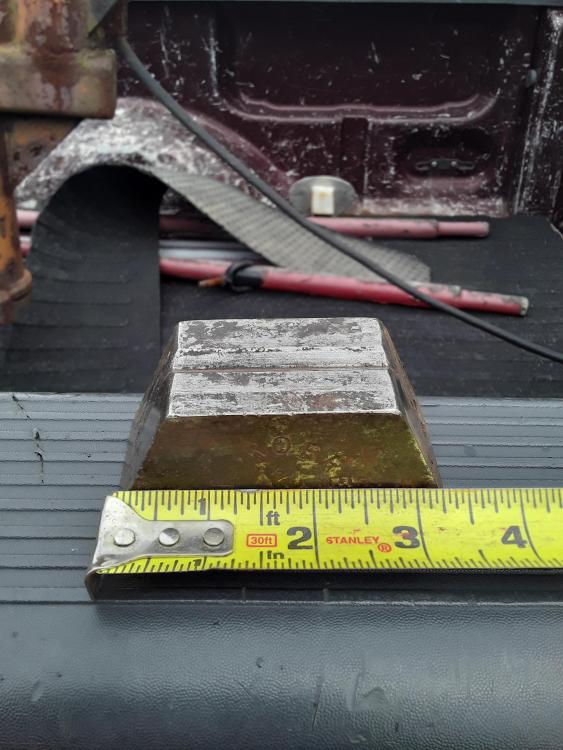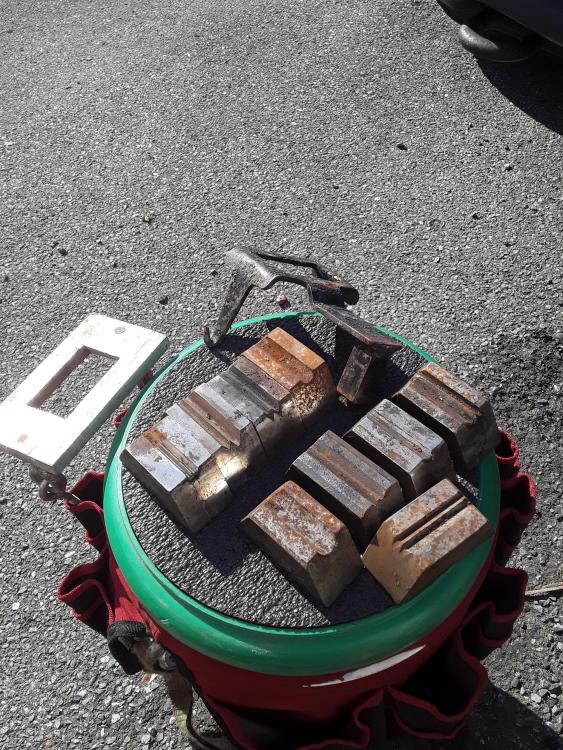-
Posts
542 -
Joined
-
Last visited
Content Type
Profiles
Forums
Articles
Gallery
Downloads
Events
Everything posted by George Geist
-
No, never had the pleasure of making the gentleman's acquaintance.
-
Cool, I'd be interested. You still have fire pots for sale?
-
Thanks for PM. JM, The thing you're talking about did get fixed in PA for a few years but this year they changed the law which enables them do legally do what they were previously doing illegally. As long as there is no national governing body, and it continues to be overseen by state commissions it will continue to have frequently changing rules in every jurisdiction impossible to keep up with by anybody. All I can tell you is to best of my knowledge the only place in this country that everybody definitely gets tested is California. Aside of that its easier than ever to get on a racetrack right now and when someone is licensed and in there is no getting rid of them. George
-
The Thoro'bred ones I'm posting pictures of, are those the ones you saw in that store Charles? George
-
I'd say if I was looking to forge them I'd be inclined to finish the beveled edges last. Beating something down into it while it's hot to form the mold will undoubtedly booger up the edges a little bit so if you finish them last you'll clean it up real nice. Also being as they're H13 they'll air harden nice for you too. George
-
Frosty, It starts out as inch and a half square. Length of base looks like 3.5" top is 2". I cant find my protractor right now but angle can be easily figured out by drawing it on paper using those measurements. Hole in hold down is 1 and 5/8x2.
-
If you're looking to make some like those I'll dig them back out and measure dimensions, angles etc for you. Although mine were machined, they can be easily enough forged as the nice examples jlp posted. As for ones with a hardy shank, I never ever turn a hardy tool away. Although not everything will fit your hardy hole, everything will definitely fit in your vise. George
-
Hold down with hardy shank is a store bought one from Thoro'bred. You're right. It is somewhat overkill. A lot of guys cut that part off as it's not really necessary. Some guys also like a real heavy hammer for swaging. In my experience 3 or 3.5 # will suffice. Just be sure it's annealed. George
-
It helps a little to set your anvil just a little lower than you normally would because they add a little height. Hold downs let you set them over the center of the anvil. As you guys know horseshoers anvils aren't normally anymore than 125# max with most contemporary ones much lighter. Thus, if they were in a hardy hole the anvil wouldn't have enough stability. Over the meaty part of the anvil you can still whack it pretty hard without it moving as much. Section most often used in them is 1/4x1/2. 9/16 is better for some things but is entirely too hard to find around these parts. George
-
Hi Frosty, I suppose they can be made. They were made of H13 I believe. Blocks had beveled edges giving them the shape of a little trapezoid. Nicest thing about them sitting flat on the anvil with no hardy shank was that they could also be fastened to the die of a power hammer. Molds were for various types of swages and half round stock but there were also ones for belt buckles and toe grabs. I'll try to dig some out to post a pic if I can. George Some blocks and hold downs from my personal collection. George Not sure why that post copied itself, maybe mods can deal with it. My equipment doesn't normally get allowed to rust like that but those have been packed away for about 30 years.
-
Hi Frosty, I suppose they can be made. They were made of H13 I believe. Blocks had beveled edges giving them the shape of a little trapezoid. Nicest thing about them sitting flat on the anvil with no hardy shank was that they could also be fastened to the die of a power hammer. Molds were for various types of swages and half round stock but there were also ones for belt buckles and toe grabs. I'll try to dig some out to post a pic if I can. George
-
They used to be manufactured by Thoro'bred. Small blocks for swaging race plates. They looked like a hardy tool but had no shank. Were fastened to the anvil by a saddle type hold down device. I know a bunch of you guys know what I'm talking about. Question I have is without violating the site's no advertisement policy can anybody tell me if there is a place that these things can be acquired anymore? I know a fellow that needs some and mine are definitely not for sale. PM me if you prefer. George
-
Hello George, To further expound on this thing a bit. Yes you're correct in the fact unions aren't for everybody, especially artists and hobbyists etc. Labor laws in this country make it very difficult to join a union as an individual. In most situations there are only 3 ways in. 1) organize the place you work. This is a tough uphill battle that even if you're successful at you're likely to get fired over it. Been there, done that, got the t shirt. 2) take a job in an union shop. This is how most people join but in most cases they choose the job and employer. The union just comes with the deal. Many of them might not be all that pro union going in thus not an easy bunch to keep happy. 3) serve an apprenticeship Folks who do this tend to make the best union people because they choose the union. They don't ask or care who they'll be working for. Its seen in closed shop construction, maritime etc. Is probably the best way to work but downside is you spend half your life unemployed. It would be nice if people could join as an individual as they can in other countries but it is what it is. Horseshoers union was a little different. Guys who work at racetracks are all independent contractors. Except for the guy who works the paddock. Paddock blacksmith is a track employee/racing official however they choose to word it. His pay and benefits package is negotiated by the union. Their contract is pretty short and simple as it covers only one man. Pay is usually a daily rate equivalent to about 2 shoeing jobs. Contracts are usually for 3 years with raises built into them plus a benefit package on top of it. Additionally, the 3 main things the union does at the track is to get everybody on the same page with pricing, ensure bad payers don't get service till they pay up, and finally to train apprentices. The unions testing requirements ensure that only the most qualified people pass muster to work on expensive race horses. It's a symbiotic relationship that works well for everyone involved. Right now the union has a good benefit package that might be attractive for people that need it. The recent affiliation with the Boilermakers has improved that. George
-
Bumping this one up to bring everybody up to date with some current events. In regards to unions for blacksmiths, the International Union of Journeyman Horseshoers merged with the United Service Workers in 2004. It was decided in that reorganization that all the horseshoers and blacksmiths would be placed in Local 947. This union welcomed all horseshoers and blacksmiths but was perhaps best known for organizing the guys who worked at racetracks. Various track locals became chapters with elected officers and such but still all contained in Local 947. In 2019 Local 947 disaffiliated from USW and as of February of this year joined the International Brotherhood of Boilermakers. In the 1950s at some point the Blacksmiths union joined the Boilermakers, thus the only 2 unions in the US to have blacksmiths in their ranks, the Horseshoers and the Boilermakers are now all together in the same union as of this year. The Boilermakers union has a great deal to offer. I invite everyone to look at their website www.boilermakers.org For those who might be interested in getting involved with Local 947 call 631-670-5660. George BTW, My work boots are made by Carolina. Made in Pennsylvania USA by Union Labor. Price was about $100 above and beyond anything else on the shelf. I was glad to pay it. I also don't spend any money in Wally world or horrible freight or any other such places. Is a matter of principle. George
-
Is no hard and fast rule for that or anything else in the trade but one possible explanation for a 7 nail preference that I've heard anyway goes back to old world medieval religious beliefs. 7 days in week. 7 seas. Number 7 used frequently in the Bible etc. This long running tradition is still alive and well.
-
Personally I've never seen a tenotomy work. It seems to be a last ditch desperation move by some vets. I'm not saying it's always wrong. The words "always" and "never" shouldn't be in any horseshoers vocabulary. Trouble is whenever I've seen it done it's usually when a horse is going south in a hurry. As Charles can probably concur, when a horse goes in that direction nothing usually helps them and they usually die. Different shoeing methodologies tend to be hit and miss. Sometimes they work sometimes they don't. It just depends. I've probably seen barefoot work just as good more often than not too. Reason I wonder about the bleeding is it works on people right? Old timers and contemporary Amish have and had some degree of success with it. So why do contemporary shoers and vets seem to collectively turn their noses up at the idea? George
-
Thanks Charles, Glad somebody out there has some experience with this. Have you found doing this to stop any rotation and bring about stabilization? George
-
Granted I know most folks have never heard of this, just the same I heard a lot of old timers talk about this 40+ years ago when I was beginning to learn the trade. Thing I'm referring to is drilling a hole through the hoof wall in the toe area of a hot founder. Blood would spray out like a firehose at first while it relieved pressure. Soon as pressure was relieved blood would drop out in a more normal fashion till it clotted with the horse noticeably more sound. The late Burney Chapman was known to have experimented with this treatment but it's been many years since I've heard of anyone doing it. Any of you have any experience with this and if so how did it work for you? George
-
Depends, Punching out a nail hole usually either hoof packing or beeswax as previously said. Drifting through thicker stock which takes a few heats use a piece of coal or coal dust. Punches wont stick.
-
The springs were for a saddle type hold down. They were sold by thoro'bred for fastening down swage blocks. An anvil equipped as such is indicative that a previous owner was practicing swaging race plates. There were as many ways to fasten a hold down as there were to pull a clip but those tack welded pieces were sold by them and worked pretty well. Guy that had it was probably practicing for his union (JHU) test. If only anvils could talk. George
-

Help identify this horseshoe?
George Geist replied to Artifactman's topic in Farriers and Horse stuff
Yes sir, definitely. When horses were sharp shod in that manner the heels were oftentimes turned perpendicular to each other as they are in an attempt to protect a horse from injuring himself if he stepped on his opposite foot. Crosswise like a race plate sticker would be on the lateral or outside. Inline or parallel would be on the medial or inside. George -

Etiquette when working in groups
George Geist replied to Shabumi's topic in Blacksmithing, General Discussion
Sheep flock together but Eagles fly alone. Keep yourself out of such situations. Sounds like a real Chinese fire drill That geing said, such a cluster-you know what in my view would also tend to create a lot of unnecessary safety issues. When it comes to working there is NO SUCH THING as Acceptable Risk! George -
It is what appears to be a muleshoe with unfinished heels. It was an early kegshoe. Cant say what the logo meant other than it being a company makers mark. Unfinished heels enabled the horseshoer to turn calks, weld bar shoes, or cut off for an exact fit. George
-
Horse bits are best made of copper with sweet iron running a close second. Yes, sweet iron will rust but not if its wiped off and kept clean. Reason for these materials is to encourage the animal to salivate. This helps keep a good soft mouth. Stainless can be dangerous to weld or forge due to the hexavalent chromium. OSHA recently lowered the permissible exposure levels of the stuff. I'd recommend guys do their homework on the stuff before messing with it. George


